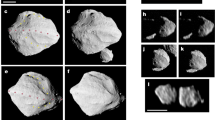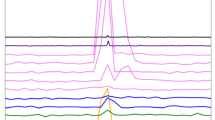Abstract
Observations of the twin QSOs 0957+561 A and B by Walsh et al.1 gave the same redshifts in both the emission line (ze=1.41) and absorption line (za=1.39) systems and also showed similar spectral characteristics in the strengths of the emission lines, absorption lines and continua. This led to the proposal that they were one object, a double image of which was being formed by an intervening massive galaxy acting as a gravitational lens. More extended observations in the 6,000–6,900 Å range2 and in the 4,000–7,000 Å region3 confirm the similarity of the two spectra and show very close agreement (14 kms−1 r.m.s.) between the velocities of the absorption line systems, thus strengthening the lens hypothesis. Other data on the structure of the associated radio sources4–6 are also consistent with the above proposition. An intervening galaxy has been looked for7 which may act as a gravitational lens: very deep red images were taken of the field using a CCD camera on the 200-inch Palomar telescope and supplemented by multichannel spectrophotometric scans of the double system. An elliptical galaxy of red magnitude 18.5 was detected which is nearly superimposed on the south (B) component of the twin QSO and which is the brightest member of a rich cluster of galaxies. The spectrophotometric data of the system show a contribution from this intervening galaxy and from the location of the characteristic Ca II 3,950 Å break, a redshift of 0.39 is estimated. Young et al.8 conclude that Q0957+561 A, B could be two images of the same object produced by this galaxy but that the lens properties are somewhat complex due to ‘aberrations’ induced by the rest of the cluster. We present here the first UV observations of Q0957+561 A, B and discuss them in terms of the lens hypothesis.
This is a preview of subscription content, access via your institution
Access options
Subscribe to this journal
Receive 51 print issues and online access
$199.00 per year
only $3.90 per issue
Buy this article
- Purchase on Springer Link
- Instant access to full article PDF
Prices may be subject to local taxes which are calculated during checkout
Similar content being viewed by others
References
Walsh, D., Carswell, R. F. & Weymann, R. J., Nature 279, 381 (1979).
Weymann, R. J., Chaffee, F. H., Walsh, D. & Carswell, R. F. Astrophys. J. Lett. (in the press).
Wills, B. J. & Wills, D. Preprint (McDonald Observatory, 1979).
Pooley, G. G. et al. Nature 280, 461, 1979.
Roberts, D. H., Greenfield, P. E. & Burke, B. F. Science 205, 894 (1979).
Porcas, R. W., Booth, R. S., Browne, I. W. A., Walsh, D. & Wilkinson, P. N. Nature 282, 385 (1979).
Gunn, J. E., Kristian, J., Oke, J. B., Westphal, J. A. & Young, P. J. IAU Circ. No. 3431 (1979).
Young, P. J., Gunn, J. E., Kristian, J., Oke, J. B. & Westphal, J. A. Preprint (Hale Observatories, 1980).
Nandy, K., Thompson, G. I., Jamar, C., Monfils, A. & Wilson, R. Astr. Astrophys. 44, 195 (1975).
Author information
Authors and Affiliations
Rights and permissions
About this article
Cite this article
Gondhalekar, P., Wilson, R. UV spectra of the twin QSOs 0957+561 A, B. Nature 285, 461–463 (1980). https://doi.org/10.1038/285461a0
Received:
Accepted:
Issue Date:
DOI: https://doi.org/10.1038/285461a0
This article is cited by
-
Sir Robert Wilson, C.B.E., FRS
Astrophysics and Space Science (1996)
-
The broad emission-line region in AGNs and quasars: The impact of variability studies
Astrophysics and Space Science (1996)
-
IUE observations of variability and differences in the UV spectra of double quasar 0957 + 561 A, B
Nature (1982)
-
VLBI structures of the images of the double QSO 0957 + 561
Nature (1981)
-
MTRLI observations of the double QSO at 408 MHz
Nature (1980)
Comments
By submitting a comment you agree to abide by our Terms and Community Guidelines. If you find something abusive or that does not comply with our terms or guidelines please flag it as inappropriate.



